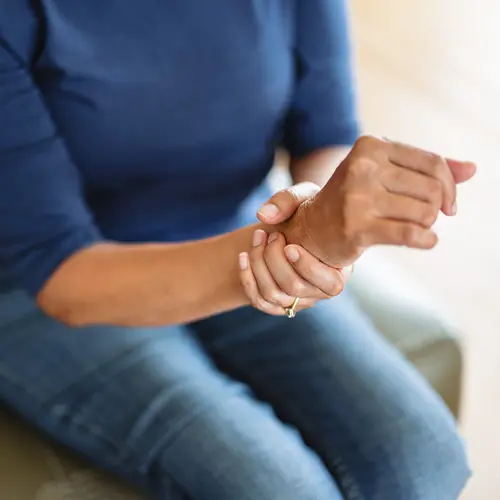By age 65, more than half of us will have X-ray evidence of osteoarthritis, a disease in which the cartilage that covers the ends of the bones at the joints breaks down and bony overgrowth occurs. For many, the result is stiffness and pain in the joint.
Although osteoarthritis (or OA) is more common as we age, it is not an inevitable part of aging. As researchers work to understand the causes of osteoarthritis, they are able to offer advice to help prevent the disease or its progression and lessen its impact on your life.
Here are four steps you can take now to prevent osteoarthritis or its progression.
No. 1: Control Weight
If you are at a healthy weight, maintaining that weight may be the most important thing you can do to prevent osteoarthritis. If you are overweight, losing weight may be your best hedge against the disease.
Obesity is clearly a risk factor for developing osteoarthritis. Data from the first National Health and Nutrition Examination Survey (NHANES), a program of studies designed to assess the health and nutrition of Americans, showed that obese women were nearly four times as likely as non-obese women to have osteoarthritis. The risk for obese men was nearly five times greater than for non-obese men.
Being overweight strains the joints, particularly those that bear the body's weight such as the knees, hips, and joints of the feet, causing the cartilage to wear away.
Weight loss of at least 5% of body weight may decrease stress on the knees, hips, and lower back. In a study of osteoarthritis in a population in Framingham, Mass., researchers estimated that overweight women who lost 11 pounds or about two body mass index (BMI) points, decreased their risk of osteoarthritis by more than 50%, while a comparable weight gain was associated with an increased risk of later developing knee OA.
If you already have osteoarthritis, losing weight may help improve symptoms.
No. 2: Exercise
If the muscles that run along the front of the thigh are weak, research shows you have an increased risk of painful knee osteoarthritis. Fortunately, even relatively minor increases in the strength of these muscles, the quadriceps, can reduce the risk.
To strengthen quadriceps, Todd P. Stitik, MD, professor of physical medicine and rehabilitation at UMDNJ-New Jersey Medical School, recommends isometric moves and wall slides. To do these, stand with your back to a wall, with feet shoulder-width apart. Then lean back against the wall, placing your feet out in front of you as far as you comfortably can. Bend at the knees, put your hands on your waist, and slide with your spine, maintaining contact with the wall until you reach a sitting position. (Your knees should not bend more than 90 degrees). Then slowly slide back to your original position. Repeat eight to 10 times.
If fear of joint pain after exercise keeps you from exercising, try using heat and cold on painful joints or take pain relievers. Doing so may make it easier to exercise and stay active. The safest exercises are those that place the least body weight on the joints, such as bicycling, swimming, and other water exercise. Light weight lifting is another option, but if you already have osteoarthritis, first speak with your doctor.
No. 3: Avoid Injuries or Get Them Treated
Suffering a joint injury when you are young predisposes you to osteoarthritis in the same joint when you are older. Injuring a joint as an adult may put the joint at even greater risk. A long-term study of 1,321 graduates of Johns Hopkins Medical School found that people who injured a knee in adolescence or young adulthood were three times more likely to develop osteoarthritis in that knee, compared those who had not suffered an injury. People who injured their knee as an adult had a five times greater risk of osteoarthritis in the joint.
To avoid joint injuries when exercising or playing sports, the National Institute of Arthritis and Musculoskeletal and Skin Diseases recommends the following:
- Avoid bending knees past 90 degrees when doing half knee bends.
- Keep feet as flat as possible during stretches to avoid twisting knees.
- When jumping, land with knees bent.
- Do warm-up exercises before sports, even less vigorous ones such as golf.
- Cool down after vigorous sports.
- Wear properly fitting shoes that provide shock absorption and stability.
- Exercise on the softest surface available; avoid running on asphalt and concrete.
If you have a joint injury, it's important to get prompt medical treatment and take steps to avoid further damage, such as modifying high-impact movements or using a brace to stabilize the joint.
No. 4: Eat Right
Although no specific diet has been shown to prevent osteoarthritis, certain nutrients have been associated with a reduced risk of the disease or its severity. They include:
Omega-3 fatty acids. These healthy fats reduce joint inflammation, while unhealthy fats can increase it. Good sources of omega-3 fatty acids include fish oil and certain plant/nut oils, including walnut, canola, soybean, flaxseed/linseed, and olive.
Vitamin D. A handful of studies has shown that vitamin D supplements decreased knee pain in people with osteoarthritis. Your body makes most of the vitamin D it needs in response to sunlight. You can get more vitamin D in your diet by eating fatty fish such as salmon, mackerel, tuna, sardines, and herring; vitamin D-fortified milk and cereal; and eggs.
Reducing Osteoarthritis Pain
If you already have osteoarthritis, these same steps can be useful for reducing pain and other symptoms. In addition, there are many treatments your doctor can recommend or prescribe. They range from over-the-counter pain relievers to injections of corticosteroids or other compounds and, eventually, surgery to replace the painful, damaged joint.

